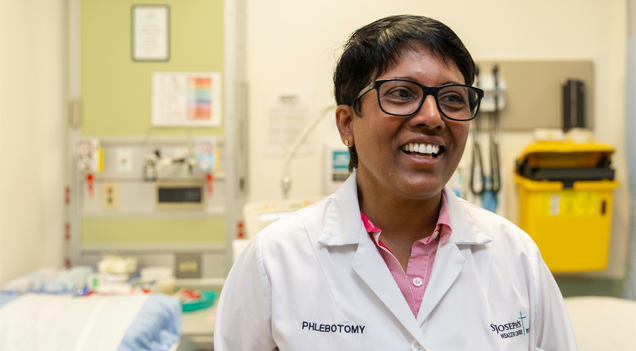Faster, better ED care

 Most patients probably don’t think twice about who’s drawing their blood or starting their IV in the hospital. But in St. Joseph’s Emergency Department, it’s because of who’s doing this that patients are receiving care faster.
Most patients probably don’t think twice about who’s drawing their blood or starting their IV in the hospital. But in St. Joseph’s Emergency Department, it’s because of who’s doing this that patients are receiving care faster.
An innovative collaboration has placed our phlebotomists (also known as medical lab technicians, or MLAs) — who traditionally work behind the scenes and in outpatient clinics — right in the heart of our busiest area, helping relieve pressure on nurses and physicians.
Two years ago, MLAs started drawing blood in the ED, performing the task that would typically take nurses away from other pressing priorities. As an added benefit, because the MLAs are specially trained in blood collection, there were fewer errors related to the samples and labeling, preventing patients from having to have blood drawn multiple times.
Taking it one step further, MLAs have now had their roles expanded to be able to start intravenous (IV) lines, again speeding up care and freeing up capacity in other providers.
“In this situation, we had to rewrite their job description,” said Chief Technologist Yvette Williams. “We had to ensure that the current medical directives in the ED were revised to include permission for MLAs to start the IV lines. What was really great was that most of our MLAs were already trained in this area and they were excited to be able to do it.”
“I love the Emergency Department environment,” said Jeya Nadesalingam, a phlebotomist. “I did a trial placement here and loved it so much I didn’t want to leave. It’s lively and active and it lets me constantly interact with patients which is very rewarding.”
EDs are busy places and St. Joseph’s is busier than most, with more than 100,000 people coming through each year. When MLAs were only able to draw blood, patients still had to wait for a nurse to do an IV insertion. Having MLAs able to do both means there’s less waiting for patients.
“They’re taking on more of an active role in what is really a teambased environment,” said laboratory manager Adnan Khan, “We’ve heard positive feedback from everyone – both the MLAs and nurses are learning from one another and appreciating what the other is doing.”
Because of the success at St. Joseph’s, a similar model is being implemented at St. Michael’s.
“Our main goal is always to do what’s best for our patients,” said Williams. “And having specialized MLAs supporting other providers in the ED means patients are having fewer samples taken, there’s a lower risk of error and patients can move through as quickly as possible.”
